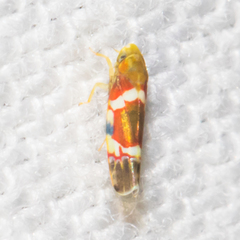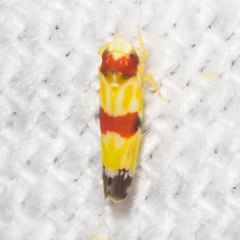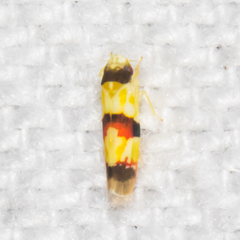Three banded Leafhoppers/Erythroneura spp et al
Last year I spent some time trying to identify a three-banded leafhopper, which led me to comparing a lot of images of Erythroneura spp on BugGuide. Yesterday I was tagged on one and it got me looking at them again. I thought if I put some images together it might help me (and possibly others) to get to the right species a little easier.
(All the usual disclaimers go with this post. I'm not an expert, just an avid researcher when something interests me. Any species will have variations. This post is not exclusive of any other similar looking species, but I'll try to add them as they come up. You should not rely solely on this post for ID; BugGuide is still the best layperson resource. Consumption may cause stomach upset and/or a laxative effect. Offer valid only at participating locations.)
It's helpful to note that the background yellow stripes can also be red/orange, but the pattern of the brown bands is the first place to start.

Erythroneura calycula (Three-banded Leafhopper)
The first band is thinly U-shaped, covering primarily the eyes. All bands are brown.
BG images: https://bugguide.net/node/view/267669/bgimage

Erythroneura cymbium
The first band looks squared or like a barbell more than U-shaped. All bands are brown.
BG images: https://bugguide.net/node/view/702934/bgimage

Erythroneura tricincta (Three-banded Leafhopper)
The first band is wide and covers almost the entire pronotum. All bands are brown. Note the same common name as E. calycula.
BG images: https://bugguide.net/node/view/18115/bgimage

Erythroneura bistrata
The first band is wide and comes to an angle at the legs. (This is a key feature to differentiate bistrata and tricincta. The distal (bottom) edge of the 1st band curves forward in bistrata creating the angle, and backward in tricincta.) The second band is usually irregular or mask shaped instead of straight lines. The bands often have red coloration too.
BG images: https://bugguide.net/node/view/228988/bgimage

Erythroneura vitis (Grapevine Leafhopper)
This species has very distinct marks that look like a white circle with a red outline on a brown body. The white bands will be thinner, all edged in red, and the 2nd brown band will be rounded not mask shaped.
BG images: https://bugguide.net/node/view/36023/bgimage

Erythroneura diva
The 1st band is brown with red overlaying it. The 2nd is red with brown only on the sides.
BG images: https://bugguide.net/node/view/287060/bgpage

Erythroneura integra
The 2nd band is brown with red overlaying it and slightly lower.
BG images: https://bugguide.net/node/view/540391/bgimage

Eratoneura arpegia, amethica OR trivittata
The head has no brown band on it. The 1st band curves forward like Erythroneura bistrata, but the 2nd band is brown on the sides and red in the middle. The 3rd band is brown, or red with a brown dot. Note that this is a different genus than the other examples. The species are currently combined on BugGuide into a complex and not in separate species.
BG images: https://bugguide.net/node/view/1485152/bgpage
If you have input on corrections, please comment or message me! These are grossly simplified descriptions for quick ID, but please consult BugGuide for full descriptions and details.
For other genera with similarities, also review
Eratoneura sp https://bugguide.net/node/view/512271
Empoa sp https://bugguide.net/node/view/1492584
Ossiannilssonola sp https://bugguide.net/node/view/723009
Additional resources:
Many Erythroneura have subspecies where one of them will have the three-banded look. Ex: E. rosa var repetita. It's worthwhile reviewing the images at https://www.semanticscholar.org/paper/Review-of-the-New-World-Erythroneurini-(Hemiptera%3A-Dmitriev-Dietrich/5617d15be17a0ce795c9bb28c50ecf3bb3f21fe7
Photo credits:
E. calycula - John Boback; https://www.inaturalist.org/observations/7126938
E. cymbium - Kimberlie Sasan; https://www.inaturalist.org/observations/7290394
E. tricincta - Royal Tyler; https://www.inaturalist.org/observations/14321359
E. bistrata- Ken-ichi Ueda; https://www.inaturalist.org/observations/7678269
E. vitis - Timothy Reichard; https://www.inaturalist.org/observations/14737151
E. diva - Timothy Reichard; https://www.inaturalist.org/observations/14736007
E. integra - Timothy Reichard; https://www.inaturalist.org/observations/14816644
E. arpegia/amethica/trivittata complex - Lee Elliott; https://www.inaturalist.org/observations/1812292





Kommentit
Spectacular journal entry! Beautiful!
@gcwarbler will enjoy this too.
@kemper @pfau_tarleton @treichard @glmory
wonderful post, great work! even as a hopper enthusiast I admit that this genus in particular has intimidated me so I have shyed away from trying to appropriately understand it. Very well-presented info here.
A real boon! Thanks Kimberlie!
Great resource, Kimberlie!
(Warnings: Erythroneura may interact with your medications. Tell your physician about all your medications. Studying Erythroneura may cause drowsiness, so do not operate machinery or a motor vehicle while studying the genus.)
Ha Chuck! Glad somebody reads the fine print ;)
Lisää kommentti